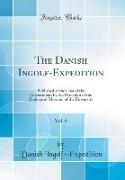The Danish Ingolf-Expedition, Vol. 6
BücherAngebote / Angebote:
Excerpt from The Danish Ingolf-Expedition, Vol. 6: Published at the Cost of the Government by the Direction of the Zoological Museum of the UniversityThe skeleton is chiefly of the same structure as in the foregoing species, and built upon the principle which upon the whole is found in the Longitudinal fibres (primary fibres) run longitudinally through the sponge, and spread to all sides like a sheaf, reaching to the surface where they' project a little, they are united by transverse fibres (secondary fibres) into a rather regular net work. Far the greater part of the longitudinal fibres are polyspicular, but with far fewer spicules than in the foregoing species, and also unispicular fibres are seen, otherwise the fibres are somewhat different with regard to their thickness and the number of spicules, the thickness being about between the thickness of a spicule and and the distance between the longitudinal fibres is ca. 0'12mm thus the fibres are considerably thinner and the reticular work finer than in the foregoing species. Neither do the transverse spicules here form coherent fibres, but reach only from one longi tudinal fibre to the next, and are for a great part formed of but one spicule, in the inner part of the sponge thev are far from each other, so that the meshes are more or less rectangular, but towards the surface they are nearer to each other, and here the meshes are more or less quadratic. The spongin is not bv far so strongly developed as in the foregoing species, and most frequently it forms no distinct sheath or only a very thin one round the spicules of the fibres, in the nodes it is distinctly seen, the transverse spicules are not generally quite surrounded by spongin, but only cemented at the ends. Besides the skeletal tissue thus constituted, some fibres are seen here and there running longitudinally along the branches without going to the surface, which fibres may divide and anastomose, they are a little stronger than the regular longitudinal fibres, and have more spongin forming a distinct sheath. Towards the base of the sponge the amount of spongin is greater, and the spicules of the fibres are here surrounded by a distinct spongin-sheath. In the hard, solid stalk the amount of spongin is verv considerable, and at the same time it passes from colourless to yellow, the intervals between the fibres are here very small, and the whole mass forms a very solid tissue.About the PublisherForgotten Books publishes hundreds of thousands of rare and classic books. Find more at www.forgottenbooks.comThis book is a reproduction of an important historical work. Forgotten Books uses state-of-the-art technology to digitally reconstruct the work, preserving the original format whilst repairing imperfections present in the aged copy. In rare cases, an imperfection in the original, such as a blemish or missing page, may be replicated in our edition. We do, however, repair the vast majority of imperfections successfully, any imperfections that remain are intentionally left to preserve the state of such historical works.
Folgt in ca. 10 Arbeitstagen
